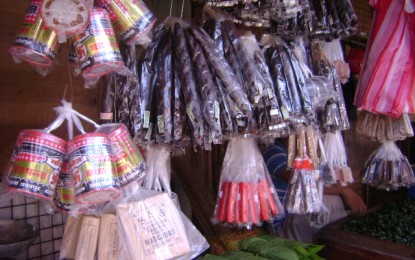
ZAMBOANGA CITY -- Feeling blue or tired? Chew a “mama,” get high, and feel good.
The “mama” here is not one’s tough mother, but the betel nut and leaf concoction or quid that is still popularly indulged on in Zamboanga City and the regions around it.
Many Muslim men and various Christians as well relish it as stimulant that raises alertness and feeling of lightness of body.
This is how Jasper Sakilal described the effects of betel chewing. Jasper sells betel nuts and leaves from a stall in the city’s main public market.
Some 11 makeshift stalls forming a row sell the stuff, all operated by Muslim vendors, located amid a bedlam of vendors selling fish, shells, seaweeds, vegetables, “ukay-ukay” and carinderias.
It is where one can get cheap but strong native coffee plus native delicacies and delicious, spicy Tausug dishes.
Jasper, a Tausug college graduate from Jolo, said it is not just the old Muslim men who chew betel, as it is commonly perceived or portrayed.
“Many young Muslims and Christians buy betel from us here in this market”, he said. “Even students buy and use betel because they say it helps them focus on their lessons. Many policemen also chew betel to keep them alert while on duty”.
Jasper said some people chew betel to lower their blood pressure.
However, the medical jury, according to internet literature, is still out on the benefits of betel, although it has been in use for thousands of years mainly in Asia and subcontinent India.
Jasper said a betel nut roll is made up of a betel leaf, locally called “buyu,” that wraps around a slice of betel nut -- locally called “bonga”.
The leaf comes from a creeper vine grown commercially, the bonga from a coconut-like tree.
A bonga paste scraped from the fresh nut is also sold to those who prefer it instead of a slice of the nut itself.


An inorganic lime may also be mixed with the bonga paste locally called “apok” to hasten the body’s absorption of the natural substances contained in the nut and leaf.
Jasper said some people even add a sliver of tobacco and a dash of honey to enhance the flavor.
Braided tobacco leavers placed in plastic tubes (used in ice candy) including shredded tobacco bought from Pangasinan are sold at these stands.
It can be addictive, Jasper said, that’s why some people chew as many as 20 rolls in a day. Jasper himself does not chew after how he got dizzy and vomited when he tried it for the first time.
“Betel is not good for some people”, he said.


A kilo of these leaves costs PHP45, but can also be bought for PHP10 for seven pieces, he said. The nuts cost as much as PHP80 per kilo, also sold at PHP10 for seven pieces. The apok is PHP20 for every small cellophane pack.
Jasper said some of their orders come from Luzon and other buyers bring this stuff abroad.
Most barangays in the city where there is a good number of Muslim residents can be seen to have stands selling betel.
Similar small portable tables selling betel is also found at the fringe of the public market. The betel leaves and nuts are grown and harvested in many parts of Mindanao, Jasper said, adding the braided tobacco is rolled locally.
According to internet literature, betel use is high in many parts of Asia, although declining in some countries.
A few countries ban it because the red-colored saliva is spitted out and makes for unsightly splatter on sidewalks, a common sight at areas of the public market.
Betel is also used in religious and social ceremonies in some Asian societies, too, according to internet literature. To its users, chewing betel means feeling better. (PNA)
